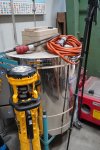Hello,
I’ve been scouring marketplace in my area, and there are Paragon high fire ceramics kilns out there for relatively cheap. I've certainly heard of people successfully using pottery kilns for knife ht, but I have two questions:
1. Is there a way to retrofit some kind of digital control measure? The kilns in question all seem to just have the low/med/high dial
2. Is this worth doing? The kilns are in the 400-600 range, so depending on possible solutions to question one, that could be cost effective. Or, should I just continue to save and get something ready-made?
My expectations would be that I’d be able to treat carbon steels and tool steels with relatively reasonable ht protocols. Wouldn’t necessarily expect it to be doing complex ramping protocols or anything.
Thanks!
I’ve been scouring marketplace in my area, and there are Paragon high fire ceramics kilns out there for relatively cheap. I've certainly heard of people successfully using pottery kilns for knife ht, but I have two questions:
1. Is there a way to retrofit some kind of digital control measure? The kilns in question all seem to just have the low/med/high dial
2. Is this worth doing? The kilns are in the 400-600 range, so depending on possible solutions to question one, that could be cost effective. Or, should I just continue to save and get something ready-made?
My expectations would be that I’d be able to treat carbon steels and tool steels with relatively reasonable ht protocols. Wouldn’t necessarily expect it to be doing complex ramping protocols or anything.
Thanks!



